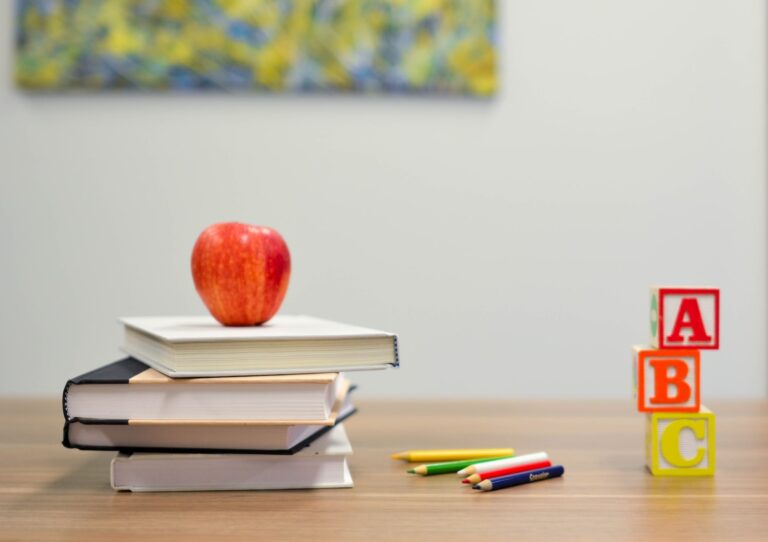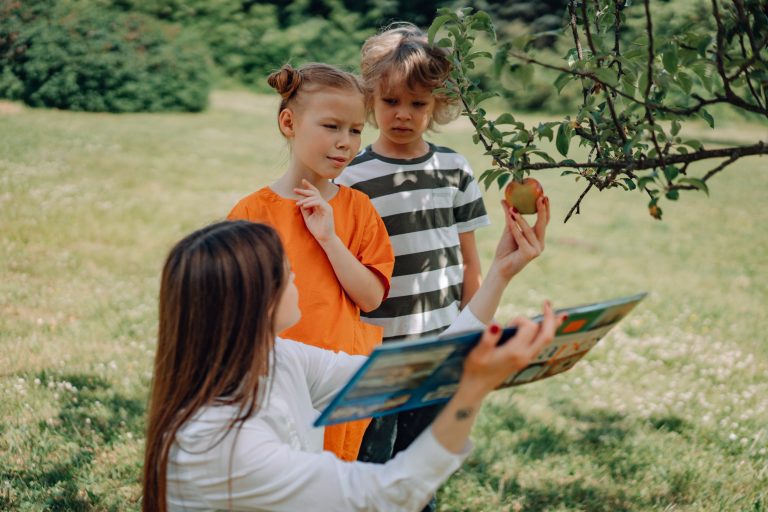How to Make a Homeschool Portfolio (And Not Get Overwhelmed!)
Making an end-of-the-year portfolio for your kids doesn’t have to be overwhelming, difficult or stressful. Just use the helpful tips in this guide, and you’ll be on your way to a finished homeschool portfolio in no time!

This post contains affiliate links, meaning that I’ll earn a small commission (at no extra cost to you) if you make a purchase using these links. As an Amazon Associate I earn from qualifying purchases. See my disclosure page to learn more.
As your homeschool year comes to an close, you may be wondering how in the world you’re going to put an entire years worth of school work into one neat and tidy portfolio. It can seem stressful and overwhelming at first, but it doesn’t have to be!
If you live in a state (like I do) that gives you the option to create an end-of-the-year portfolio as an assessment tool, then this helpful guide is for you! I’ll walk you through what you need and the steps you can take to make putting your child’s homeschool portfolio together a breeze!
In addition to being a great way to show progress, homeschool portfolios are also useful as special keepsakes to show all of the work your kids did and the memories you made over the school year.
Here’s your step-by-step guide to assembling your child’s year-end homeschool portfolio:
Step 1: Know the Requirements in Your State
Before you begin to organize or assemble your portfolio, make sure that you’re familiar with your state’s homeschooling laws. Some states might require specific records and documentation, while other states may leave it up to you as to what gets included in a year-end portfolio. To learn more about local homeschool regulations and laws, you can check with your state’s Department of Education or a homeschool advocacy group like HSLDA.
Step 2: Pick a Format
There are many different ways to set up and organize your homeschool portfolio, whether it’s physical or digital, but generally the format will fall into one of the following three categories:
- A physical binder or folder – Papers, records, documents etc. are organized and placed into a three-ring binder or folder of some type. Dividers can also be used to help organize and separate papers into subjects, semesters, chronologically, or whatever way works best for you.
- Scrapbook style – This is a creative way to organize your child’s work, projects, photos and accomplishments from the past school year. And as a bonus you’ll have a special keepsake!
- Digital Portfolio – If you’re good with technology and don’t want the hassle of saving and organizing piles of physical papers, then making a digital homeschool portfolio may be a good choice for you. With this option you create a pdf document, power point, online folder (using Google Drive, Dropbox, etc.), or even a designated website for your child’s work. Just keep in mind that if your state requires a certified teacher to review your portfolio, then they will need to be able to access all of the files/documents.
I’ve always done a portfolio in either a three-ring binder or folder for both of my kids because I prefer to organize and keep the physical papers, I’m old school like that I guess! Plus, it’s what I find to be the quickest and easiest method to show their progress and work from over the year, but any of the above options will work – just find the one that’s best for you (and meets your state’s requirements).
Step 3: Gather Your Records and Documents
A well thought out, finished portfolio can have many things that demonstrate your child’s progress and learning, as well as provide a place to keep important documents, so here are some items you may want to consider including:
- Any documentation that your state may require – In addition to this, I also keep a copy of the paperwork (and receipt/proof of mailing) that I send into my local superintendents office in each of my kids portfolios.
- Information on each child – Be sure to include your child’s name, grade level, and school year.
- Table of contents – This is optional, but may be helpful to keep everything organized and give a good overview of what’s in the portfolio.
- Attendance records or school hours – Some states might require that one of these things be done, and some may not, but I like to keep a record of what days we did school work to show that we have reached the required number of days of instruction.
- Progress reports and/or report cards – If you keep grades or do progress reports/report cards, then a portfolio is a great place to keep these records.
- Curriculum and resources used – I always find it helpful to keep a list of all of the things we used throughout the year, like curriculum, books read, textbooks, online courses/resources, supplemental materials, and any other resources you used over the year.
- Book lists – I keep a running list throughout the year of all the books (not textbooks, but fiction and non-fiction books) we read together, as well as the books each of my kids read on their own, and put this into their portfolios each year.
- Course descriptions and learning objects – This is optional, but as your child gets closer to, or enters high school, it may be helpful to have a brief summary of what was covered in each subject. This will make it easier for you when/if you have to write a detailed transcript/course descriptions for your child at the end of high school. The book Setting the Records Straight by Lee Binz is an amazing resource to help you with this – I refer to it often now that I have a child in high school!
- Field trip log – Again, this one is also optional, but if you live in a state with more strict regulations/reporting it can be a good way to record where you went for each field trip and what the purpose of each trip was. A field trip log can also be helpful to just have as a way to record where you went as well as having something to refer back to for future planning.
- Summary of the year – You may find it helpful to write a short, one page or so summary of what your child did that year. It can be broken down into what they did for each subject, or even an overview of the year as a whole.
- Work samples – These are the papers, worksheets, tests/quizzes, photos, projects, etc. that show your child’s learning and progress in each subject over the past school year. You do not need to include every assignment that your child did, rather pick the items that show the progress they made and accomplishments they had. I try to pick work samples from the beginning of the year, the middle of the year, and at the end of the year to give a good overview of their learning during that grade/year.
Here are some examples of work that you could include for different subjects:
- Math worksheets, quizzes or tests showing different concepts learned
- Writing assignments, essays, or journal entries that showcase writing progress
- Science experiments with photos, lab reports, quizzes/tests, worksheets or written observations
- Artwork or creative projects such as paintings, drawings, or crafts (you can always take pictures of the projects and use those if the actual art work won’t fit in a binder/folder)
- History timelines, reports, quizzes/tests, worksheets, or completed projects such as dioramas
- Foreign language exercises, vocabulary lists, or cultural projects
- Music or performing arts documentation, including recital programs or video links
- Physical education logs, including sports participation or fitness activities
- Handwriting or copy work samples to show progress over time
- Reports and/or scores from online programs or courses
Get these free field trip logs and reports, plus access to my entire FREE resource library!

Step 4: Highlight Achievements
An end-of-the-year homeschool portfolio is a great place to showcase your child’s skills and achievements from the past school year. They (and you!) worked hard all year, so go ahead and show it off! Here are just a few of the things you could include:
- Certificates of achievement from competitions, programs, or courses
- Awards they won
- Extracurricular activities (sports, music, volunteer work, etc.) with descriptions of involvement
- Field trips and special projects (include photos, tickets, brochures, summaries, etc.)
- Personal reflections or progress notes written by the student, parent, or someone who worked with your child
- Community service or leadership activities, including letters of recognition or documentation
Step 5: Assessments
A portfolio is also the perfect place to include any kind of assessment that was done over the year to show progress or mastery of a topic or lesson. You can have things like:
- A parent’s narrative assessment detailing strengths, challenges, and growth
- Standardized test scores (if applicable) with an explanation of performance
- Reflections on current/past goals and future learning plans to outline next year’s focus
- Grades/scores from course work, assignments, tests, quizzes, papers, etc.
- Evaluator, certified teacher, or other type of third-party assessments (if desired or required by your state)
Step 6: Organize Your Portfolio
Now’s the time when you get to put everything together! You can set your homeschool portfolio up anyway that works best for you – there is really no right or wrong way, as long as you include everything that may be required by your state.
Here are some helpful ways to arrange your child’s portfolio to keep things clear and organized:
- By Subject: Divide the portfolio into sections for each subject (math, language arts, science, etc.).
- Chronologically: Arrange work samples in order of completion to show progress over the year.
- By Type of Work: Group similar types of documents together (tests, essays, projects, artwork, etc.).
- Use Dividers and Labels: Clearly label each section with tabbed dividers in a binder/folder (or separate folders for digital files).
- Create an Index: A simple list at the beginning of the portfolio summarizing its contents.
- Color-Coding: Assign different colors to subjects or document types for quick navigation.
Digital Organization: If creating a digital portfolio, organize files into clearly named folders or sections for easy sharing.

Step 7: Store for Records and Future Reference
Yay, time to celebrate because your child’s homeschool portfolio is now complete! What you do with the finished portfolio will depend on what your state requires. You will either hold onto it for your own use, have a certified teacher review it, send it in to a designated place to have it reviewed, or whatever else your state may require.
If you do have to send it in, then I suggest you make a copy and send that in and keep the original for yourself, if possible. If not, at least try to make a duplicate, whether a physical copy or digital copy, so you have proof of completing the portfolio requirement.
If you keep the portfolio (and don’t have to send it in, or if you have the original) then just store it in a safe place for your records and future use if you ever need to refer back to anything. Plus, it makes a special keepsake with memories from your homeschool journey!
Bonus Step: Keeping portfolio items organized throughout the school year
This section isn’t so much about making your year end portfolio, but rather some helpful ways that can make assembling next year’s portfolio much quicker and easier. These ideas will help you maintain an organized system throughout the school year so when the end of the year comes, you’ll have a lot of what you need already finished – which is always a good feeling!
It took me several years of scrambling around at the end of the year, trying to find what I needed before I realized that keeping up with stuff throughout the year, and having it organized (mostly!) is a huge time saver and way less stressful! Thanks to doing some of these things below, it doesn’t take me long at all now to put my kids homeschool portfolios together at the end of year!
- Use a Filing System: Keep a dedicated folder, binder, bin, etc. for each child, sorted by subject, type of paper, semester, or however else you want to do it, and add completed assignments and projects as they’re finished.
- Scan and Save Digitally: Regularly scan or take photos of work samples, saving them in organized digital folders.
- Keep a Weekly Log: Maintain a journal or spreadsheet with notes on lessons, grades, achievements, progress, activities done, etc.
- Sort Work Monthly: At the end of each month, review and store work samples that you want to include in the final portfolio. Some people throw out the unnecessary papers each month, but I like to keep everything until the end of the year, and once the portfolio is finished, then I’ll purge what we no longer need. I just like to keep it all in case I decide later on in the year that I do want to include that document/paper after all.
- Use Storage Bins: For larger projects or crafts, use labeled storage bins to keep materials organized until it’s time to compile the portfolio.
- Backup Digital Files: Store copies of digital records in multiple locations, such as an external drive or cloud storage, to prevent data loss.
- Maintain a Running Book List: Keep a notebook, template, spreadsheet, digital document, etc. tracking books read throughout the year as they are read and finished. I have only started doing this the last couple years, but it’s been a huge help and time saver come the end of the year, and I will definitely continue keeping track of our books as we read them!
Creating a homeschool portfolio is a valuable way to reflect on the year’s learning journey. It not only fulfills potential legal requirements that your state my have, but it also provides a special record of your child’s growth, progress and achievements. By following these steps, you’ll have a well-documented, organized, and meaningful homeschool portfolio to celebrate your child’s (and your!) hard work throughout the year!







